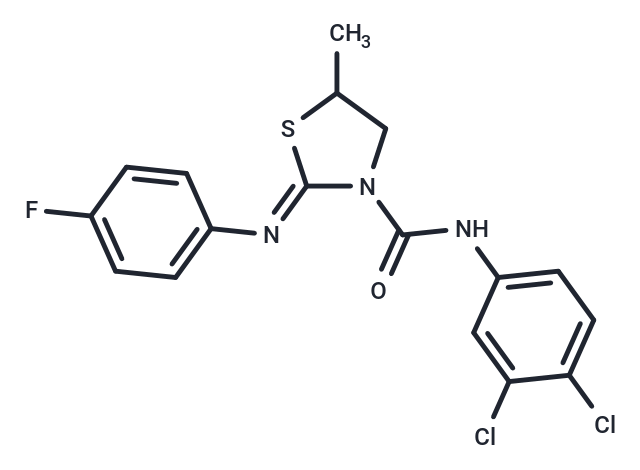Shopping Cart
Remove All Your shopping cart is currently empty
Your shopping cart is currently empty
JR-AB2-011 is a selective mTORC2 inhibitor with an IC50 value of 0.36 μM. It inhibits mTORC2 activity by blocking Rictor-mTOR association (Ki: 0.19 μM) and exhibits cytotoxicity in glioblastoma [1].

| Pack Size | Price | USA Warehouse | Global Warehouse | Quantity |
|---|---|---|---|---|
| 1 mg | $87 | 6-8 weeks | 6-8 weeks | |
| 5 mg | $213 | 6-8 weeks | 6-8 weeks | |
| 10 mg | $363 | - | In Stock | |
| 25 mg | $663 | 6-8 weeks | 6-8 weeks | |
| 50 mg | $995 | 6-8 weeks | 6-8 weeks | |
| 100 mg | $1,330 | 6-8 weeks | 6-8 weeks | |
| 1 mL x 10 mM (in DMSO) | $235 | 6-8 weeks | 6-8 weeks |
| Description | JR-AB2-011 is a selective mTORC2 inhibitor with an IC50 value of 0.36 μM. It inhibits mTORC2 activity by blocking Rictor-mTOR association (Ki: 0.19 μM) and exhibits cytotoxicity in glioblastoma [1]. |
| Targets&IC50 | mTORC2:0.36 μM |
| In vitro | JR-AB2-011 (1 μM; 24 hours) shows good anti-GBM properties, blocks mTORC2 signaling and Rictor association with mTOR [1]. JR-AB2-011 (0.5-2 μM; 48 hours) displays the least toxicity to normal neurons with no significant cytotoxic effects for concentrations up to 10 mM compared to CID613034 [1]. Apoptosis Analysis [1] Cell Line: U87 GBM cells; LN229 GBM cells Concentration: 1 μM Incubation Time: 24 hours Result: Had good anti-GBM properties and blocked mTORC2 signaling and Rictor association with mTOR. Cell Cytotoxicity Assay [1] Cell Line: Normal mature human neurons Concentration: 0.5, 1, 2 μM Incubation Time: 48 hours Result: Displayed the least toxicity to normal neurons with no significant cytotoxic effects for concentrations up to 10 mM. |
| In vivo | Mice administered JR-AB2-011 through intraperitoneal injection at doses of 4 mg/kg or 20 mg/kg daily for 10 days exhibited significant suppression of tumor growth compared to those treated with a vehicle control. Specifically, the lower dose achieved a 74% reduction in tumor growth rate with a 10-day delay in tumor progression, while the higher dose resulted in an 80% reduction and a 12-day delay. This study utilized female C.B.-17-scid mice implanted with LN229 cells, demonstrating that JR-AB2-011 is potent in inhibiting tumor growth at both tested concentrations. |
| Molecular Weight | 398.28 |
| Formula | C17H14Cl2FN3OS |
| Cas No. | 2411853-34-2 |
| Smiles | CC1CN(C(=O)Nc2ccc(Cl)c(Cl)c2)\C(S1)=N\c1ccc(F)cc1 |
| Relative Density. | 1.45 g/cm3 (Predicted) |
| Storage | keep away from direct sunlight,store at low temperature | Powder: -20°C for 3 years | In solvent: -80°C for 1 year | Shipping with blue ice/Shipping at ambient temperature. | |||||||||||||||||||||||||||||||||||
| Solubility Information | DMSO: 61.5 mg/mL (154.41 mM), Sonication is recommended. | |||||||||||||||||||||||||||||||||||
| In Vivo Formulation | 10% DMSO+40% PEG300+5% Tween 80+45% Saline: 2 mg/mL (5.02 mM), Sonication is recommended. Please add the solvents sequentially, clarifying the solution as much as possible before adding the next one. Dissolve by heating and/or sonication if necessary. Working solution is recommended to be prepared and used immediately. The formulation provided above is for reference purposes only. In vivo formulations may vary and should be modified based on specific experimental conditions. | |||||||||||||||||||||||||||||||||||
Solution Preparation Table | ||||||||||||||||||||||||||||||||||||
DMSO
| ||||||||||||||||||||||||||||||||||||
| Size | Quantity | Unit Price | Amount | Operation |
|---|

Copyright © 2015-2025 TargetMol Chemicals Inc. All Rights Reserved.